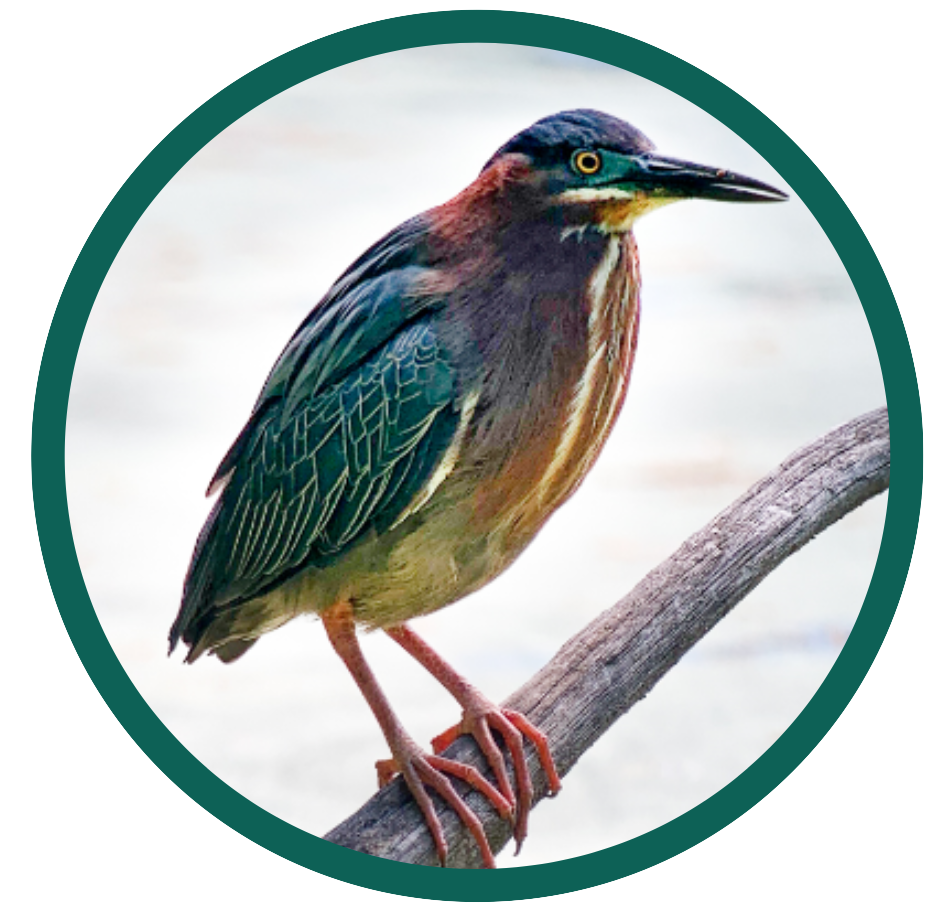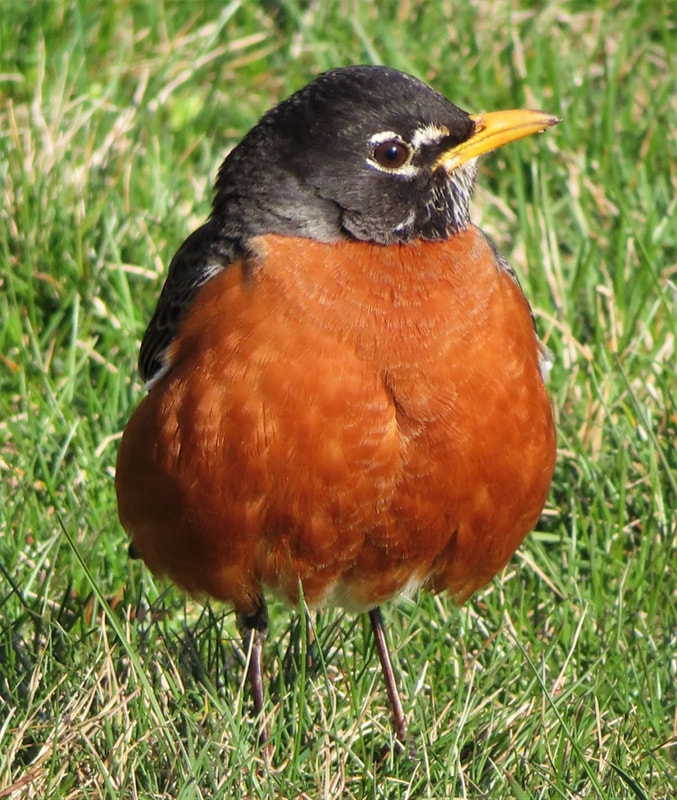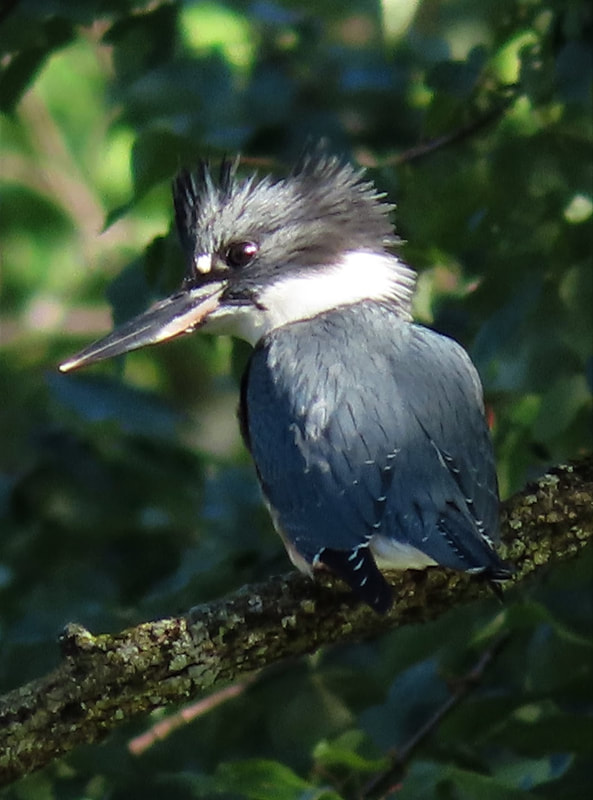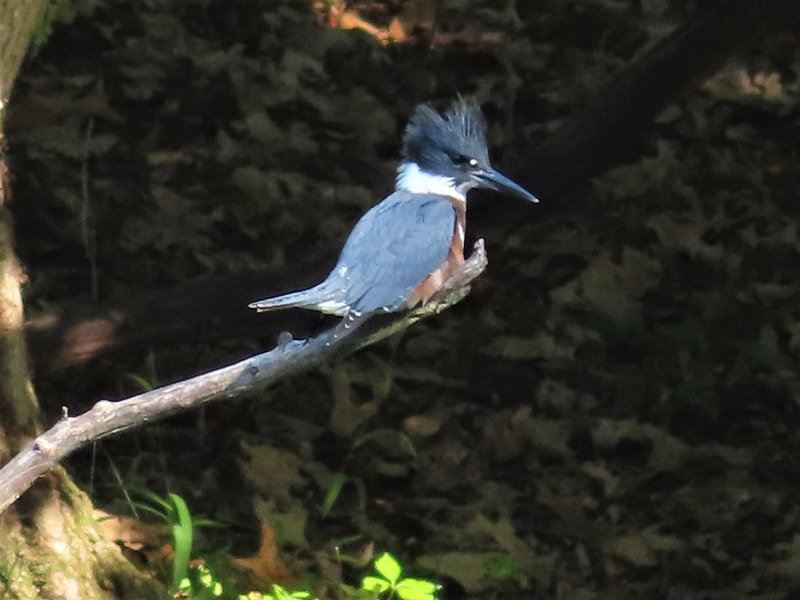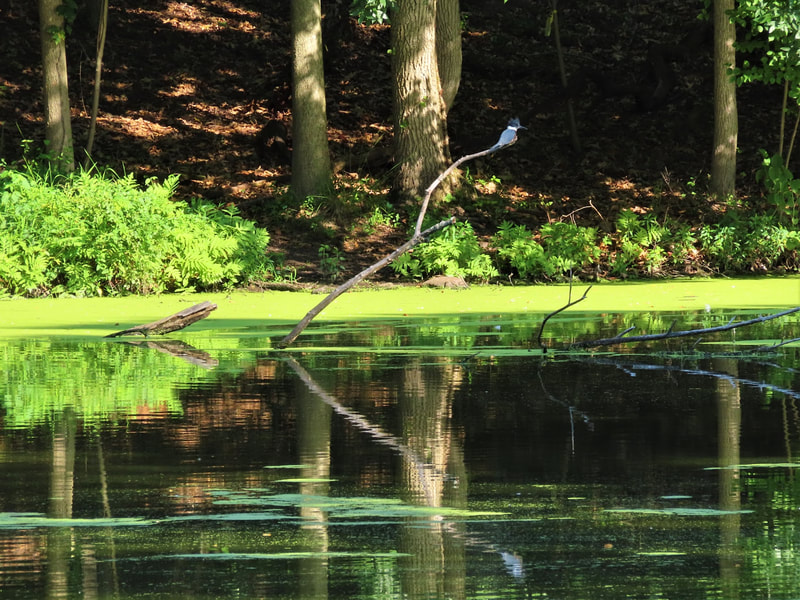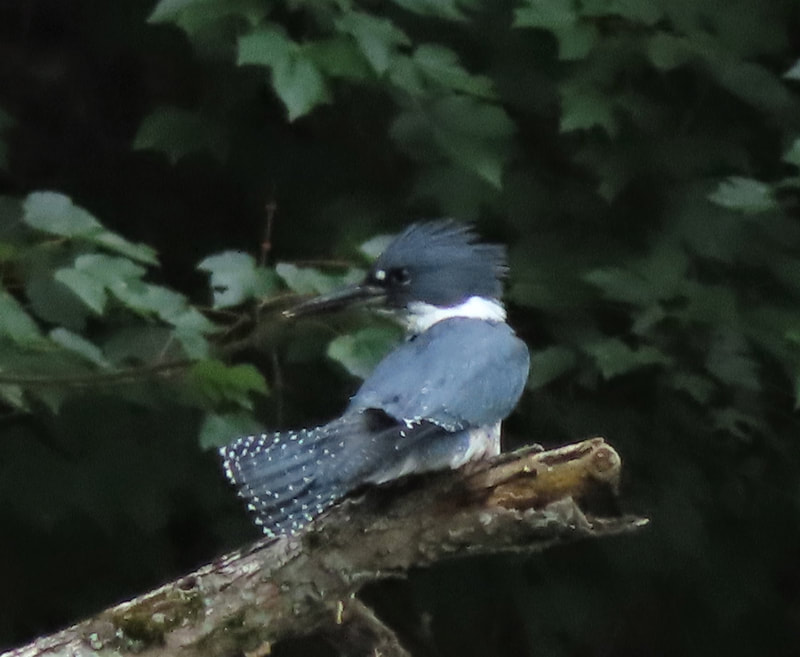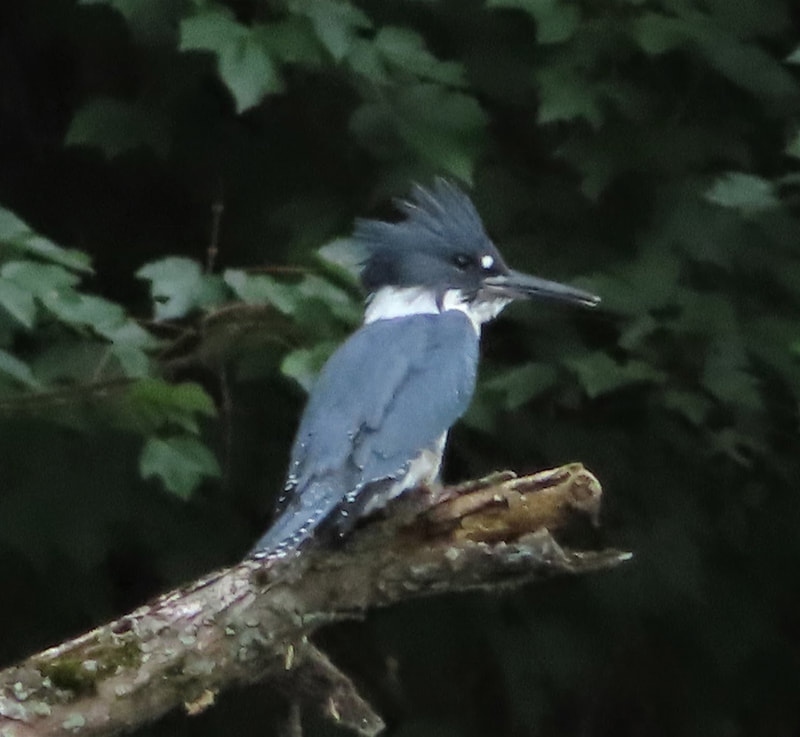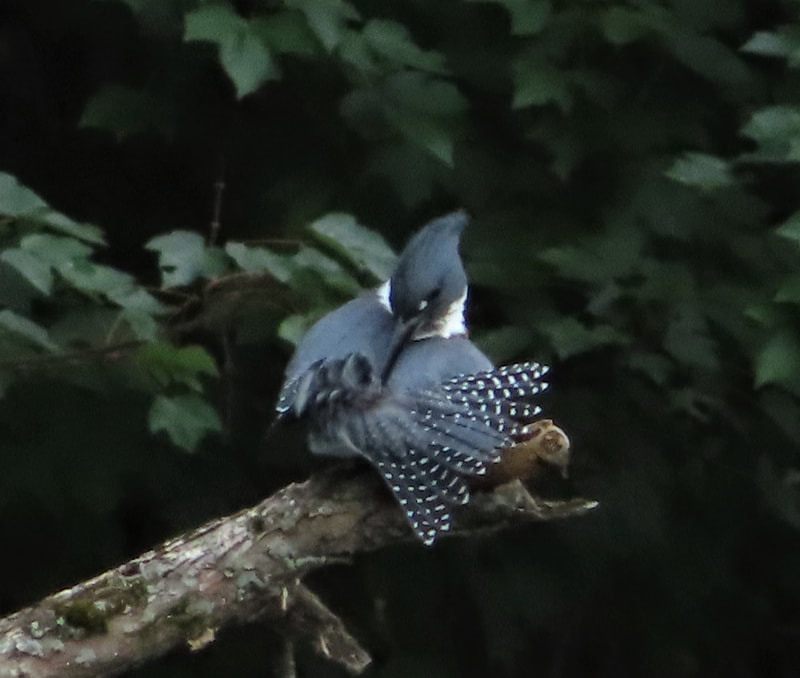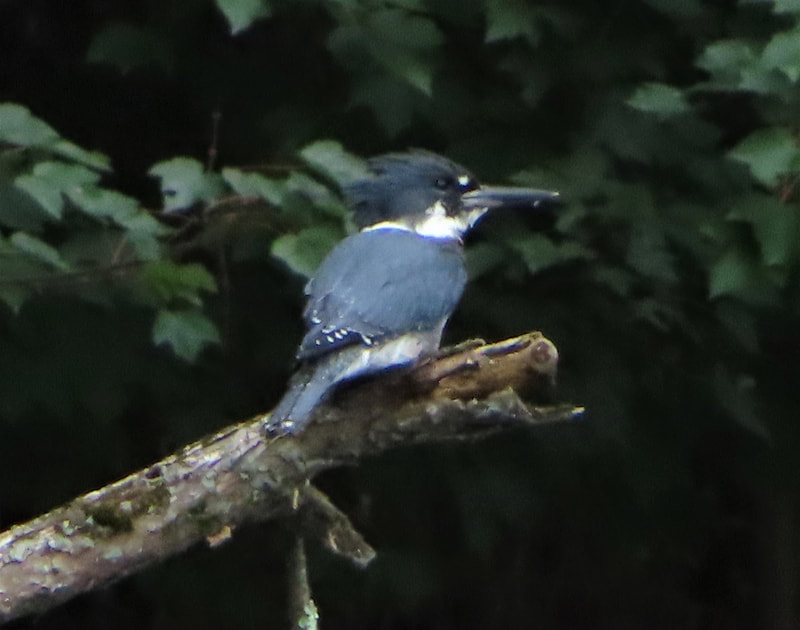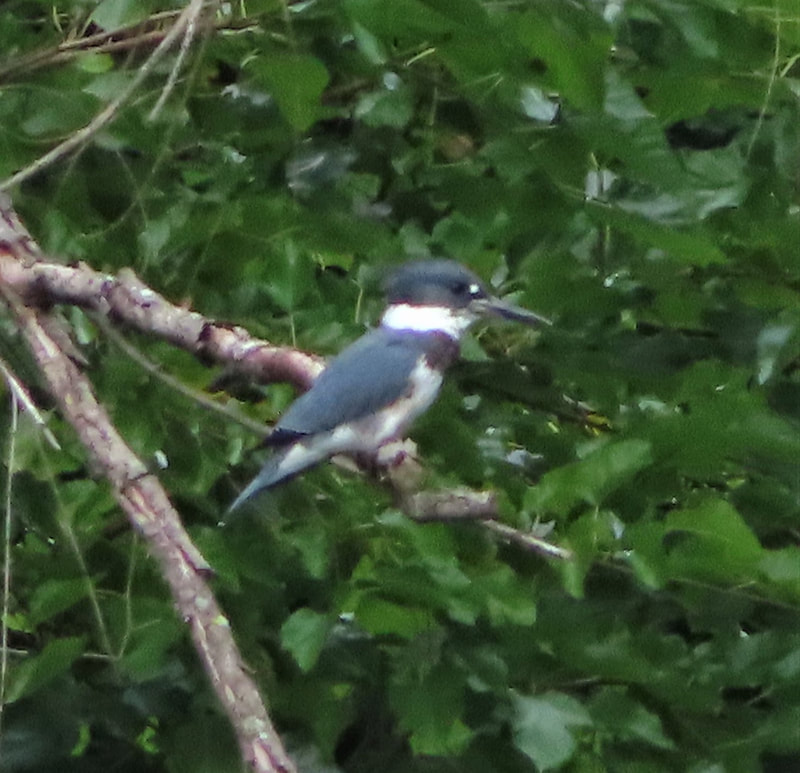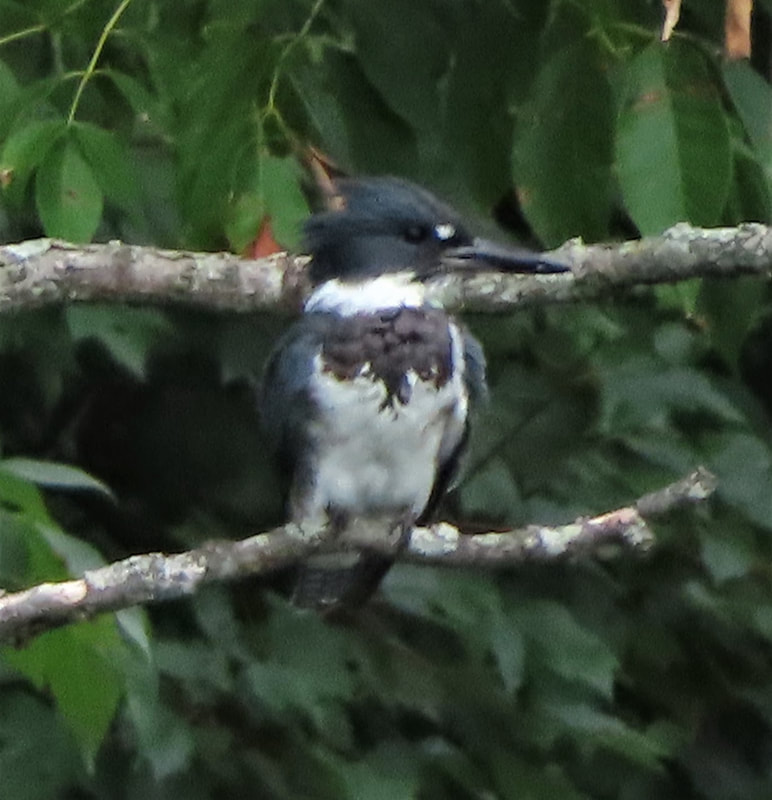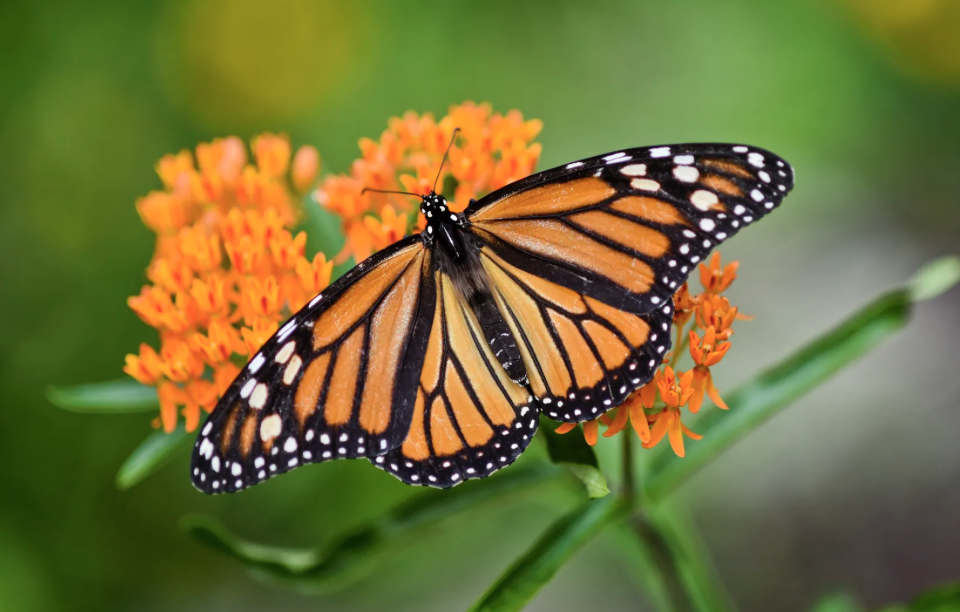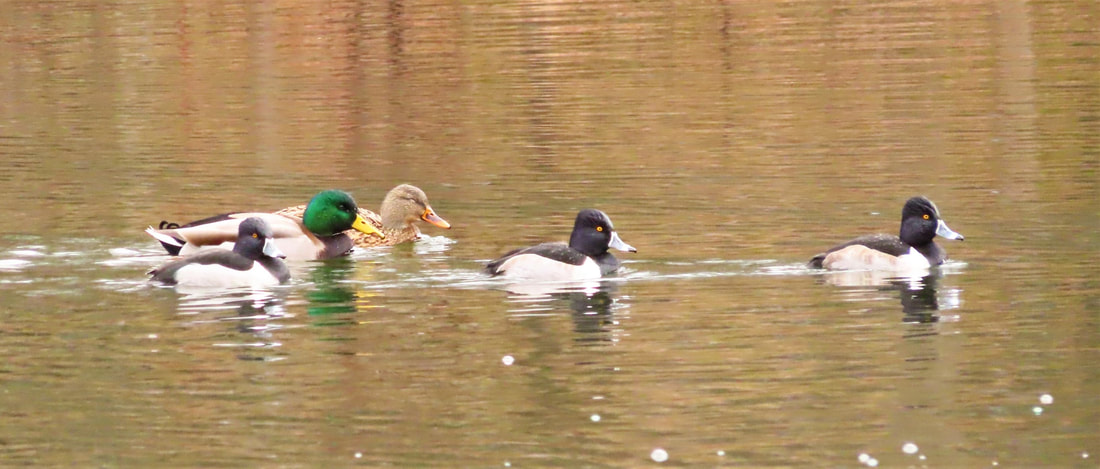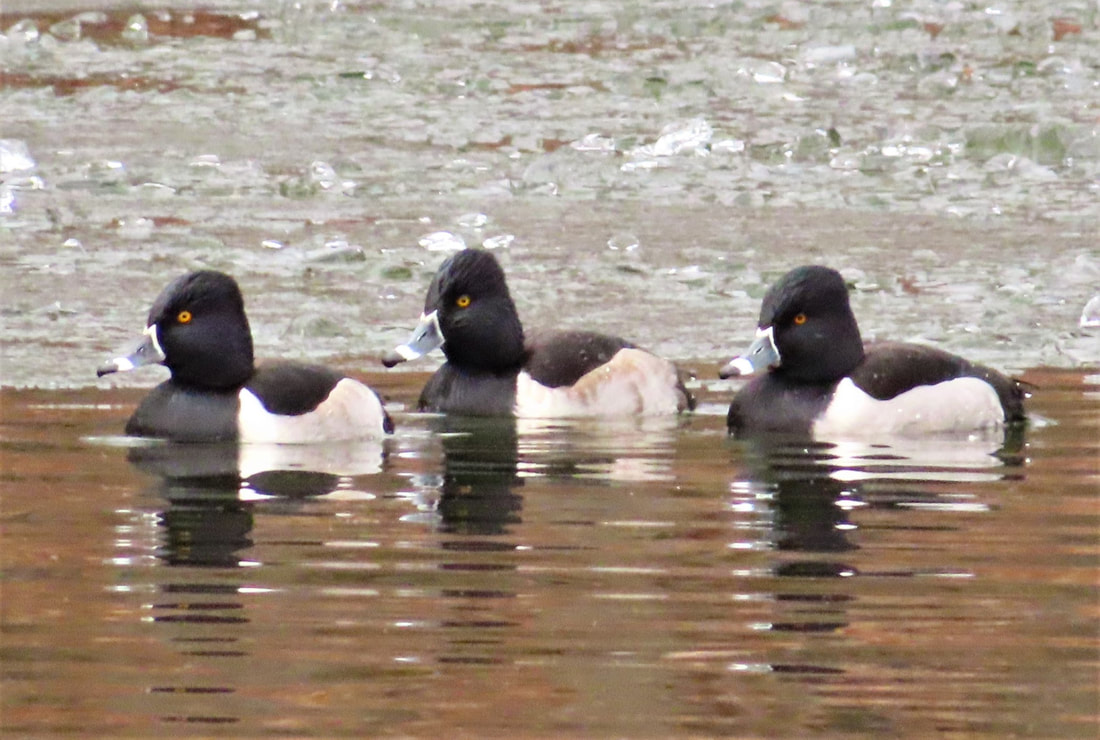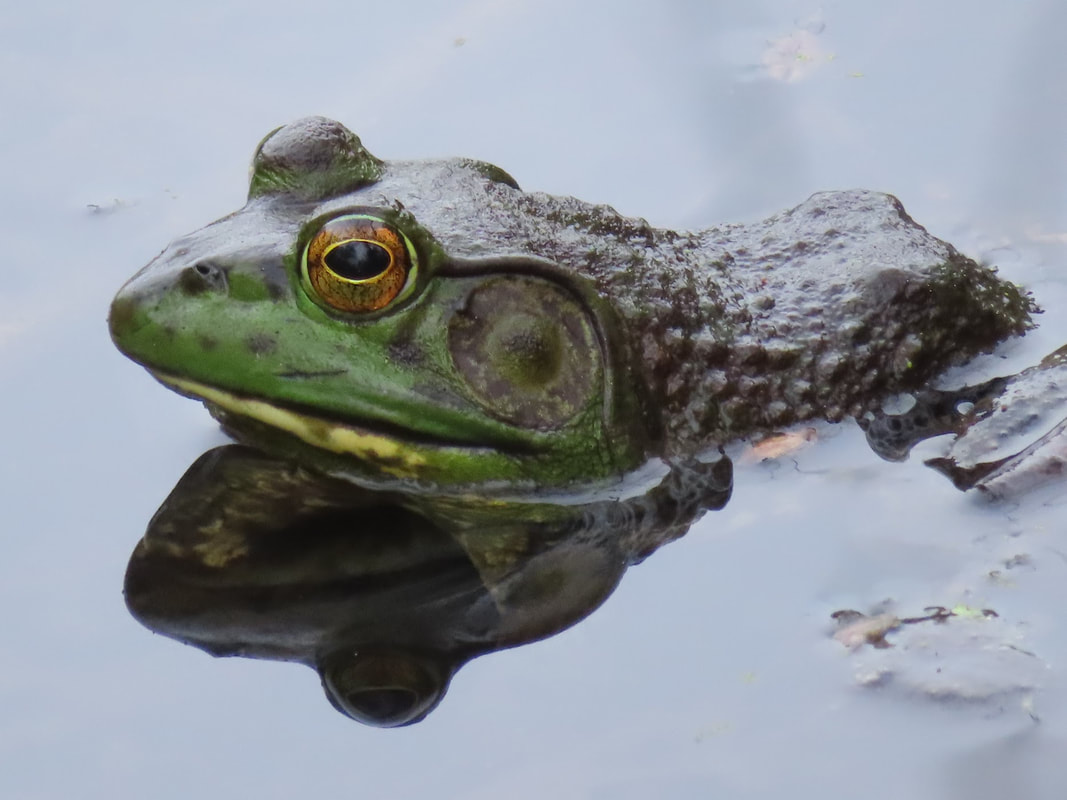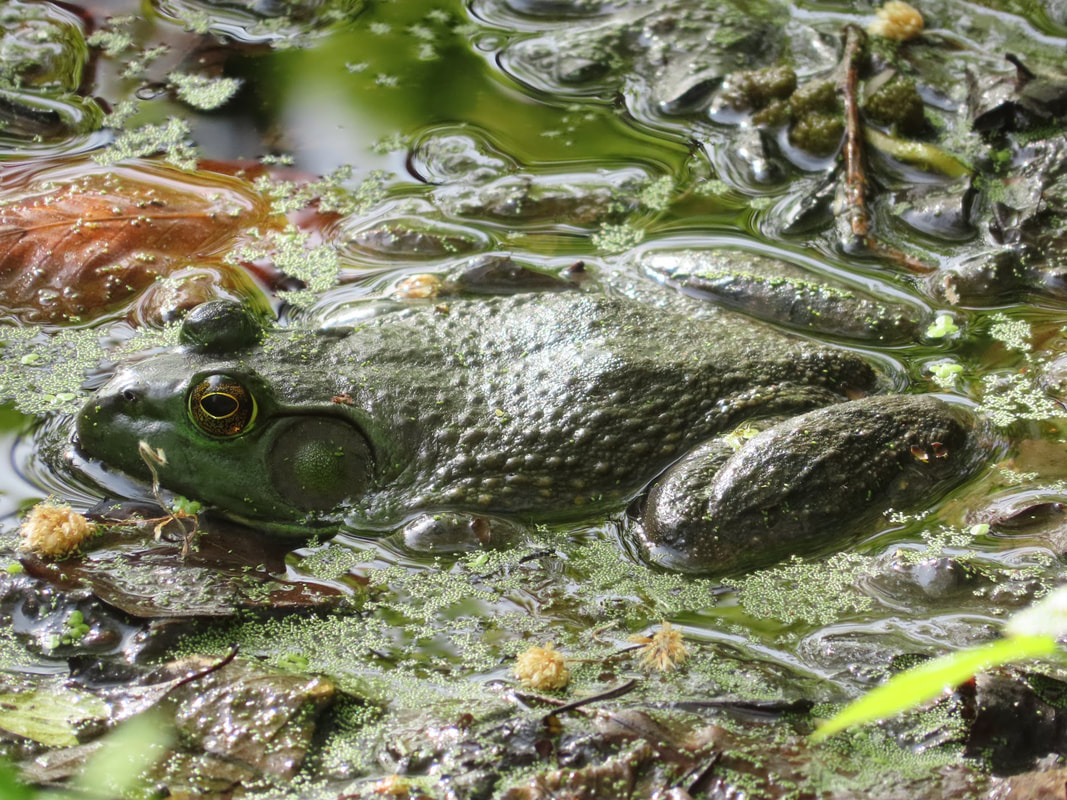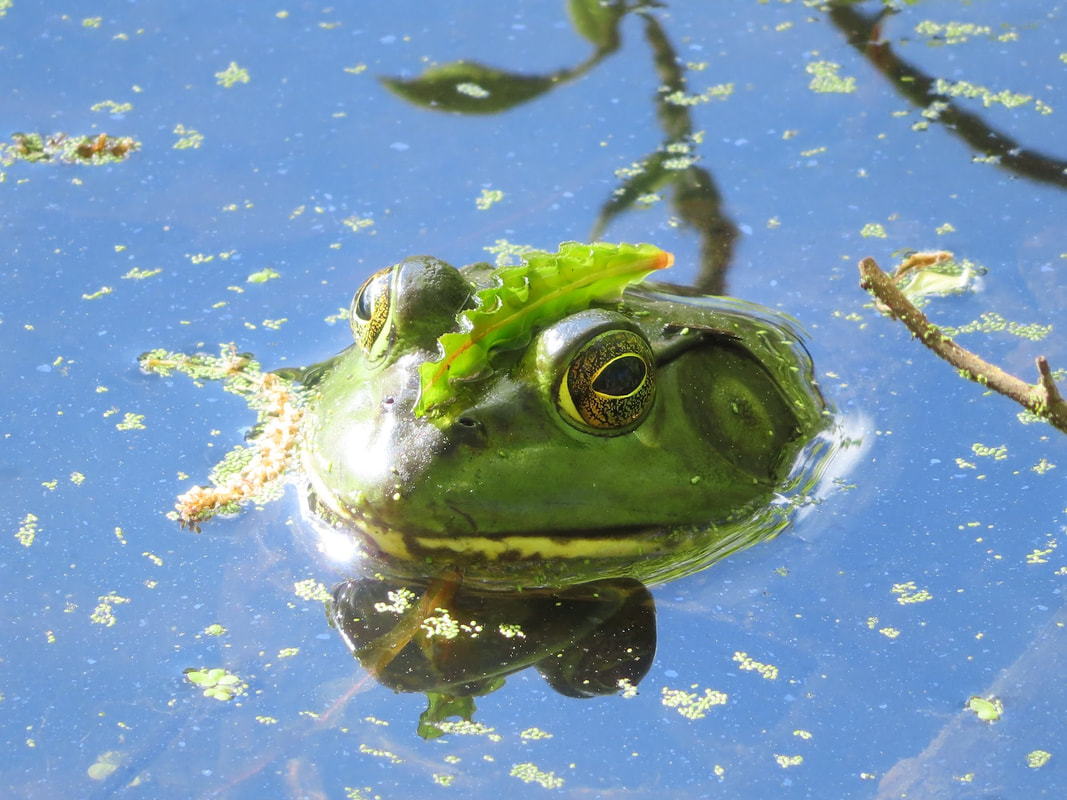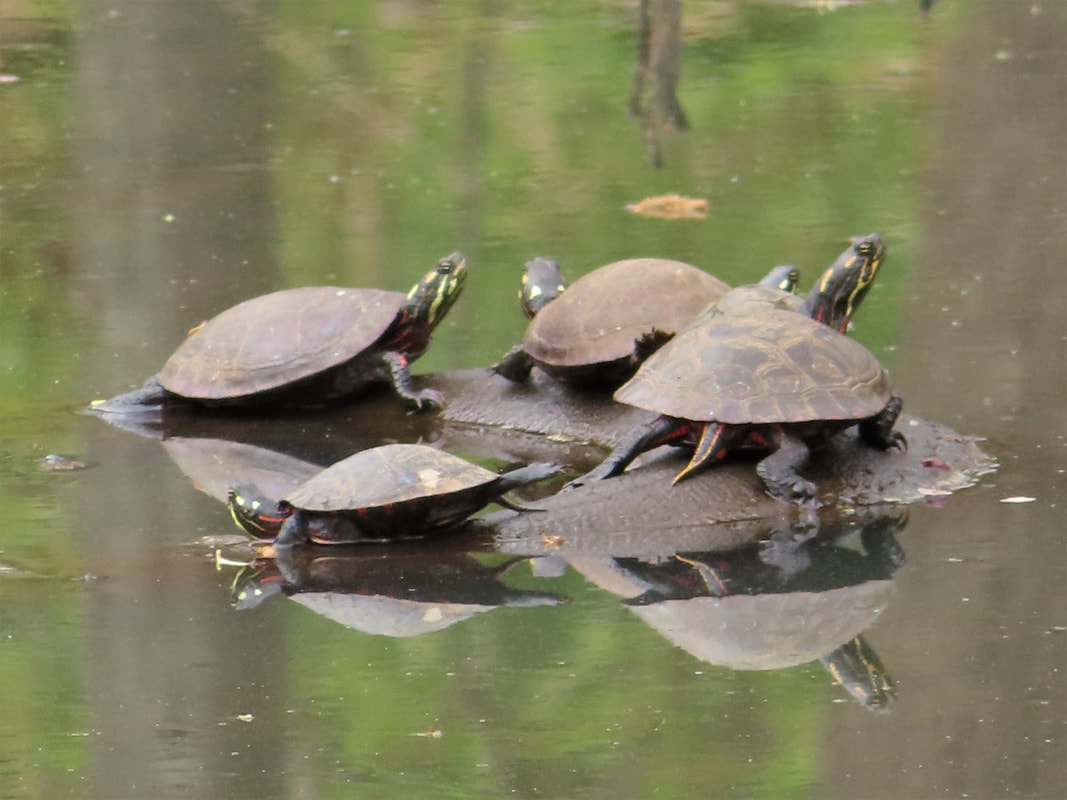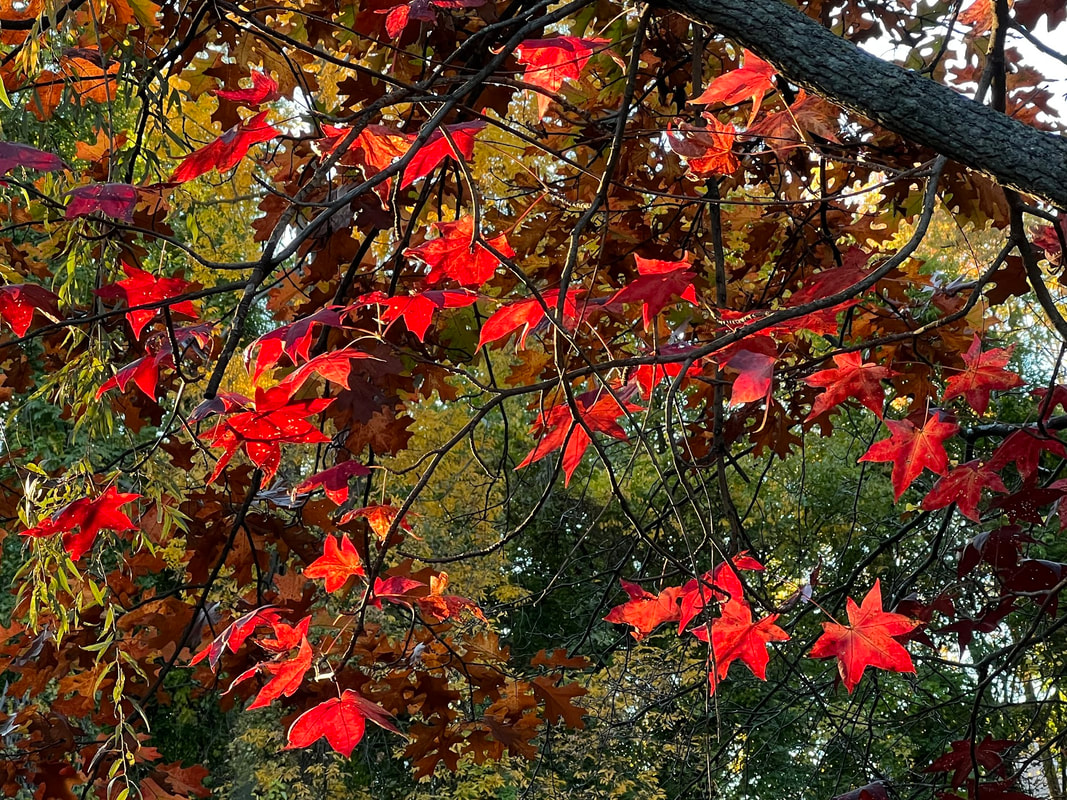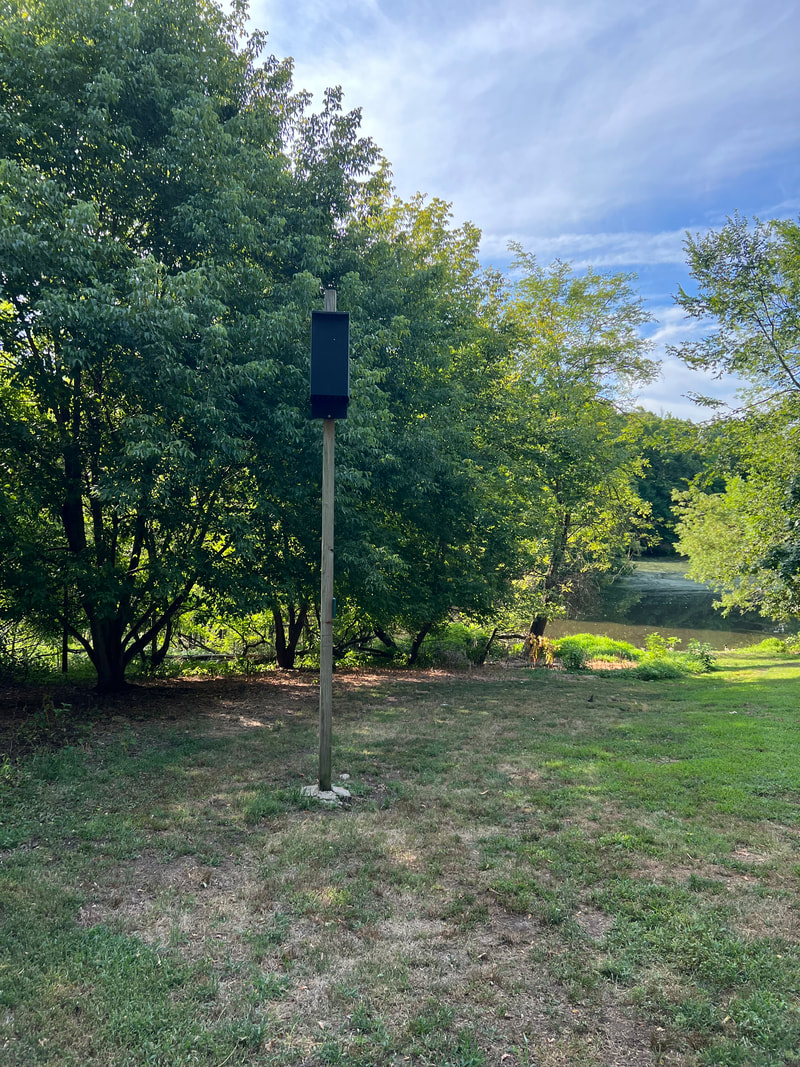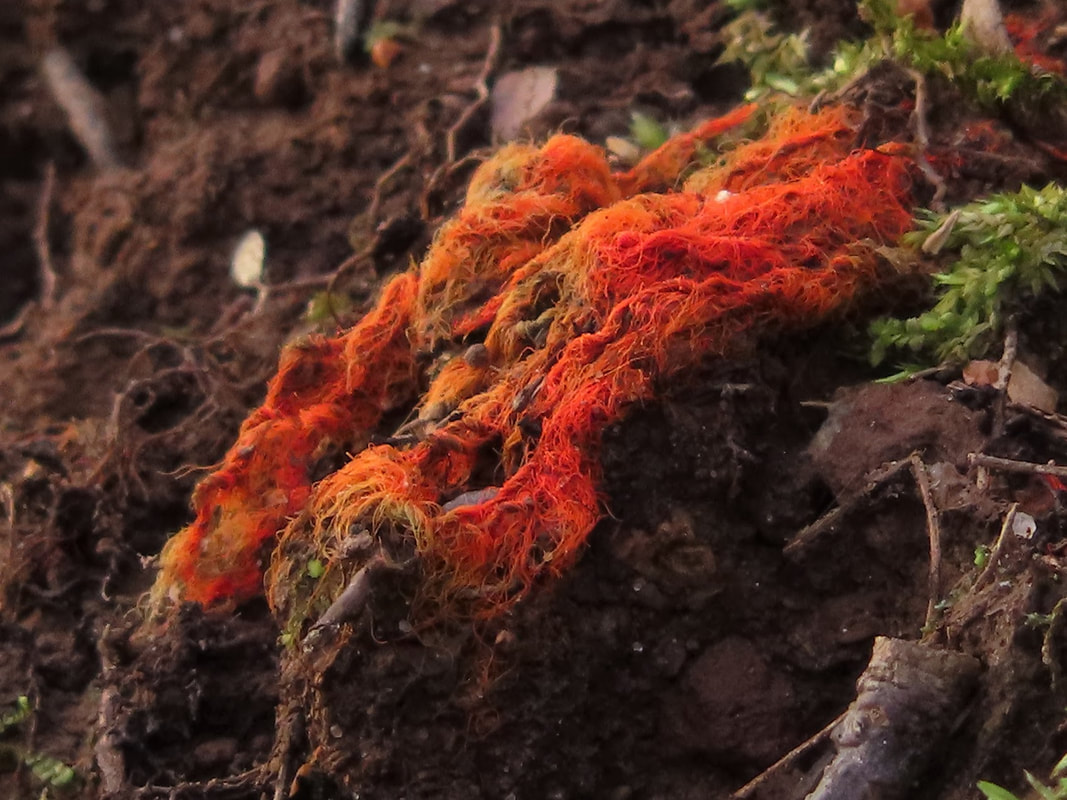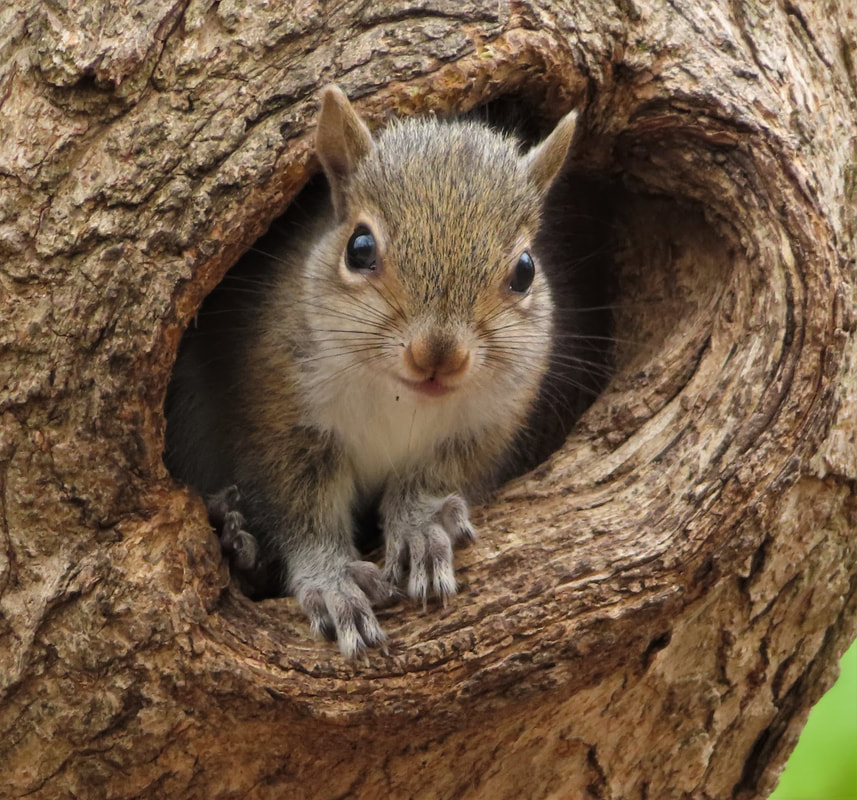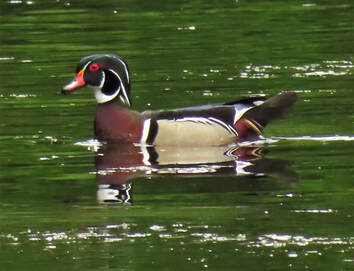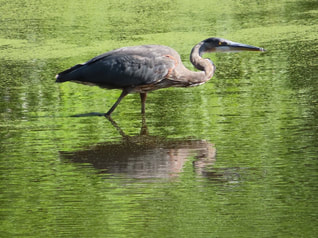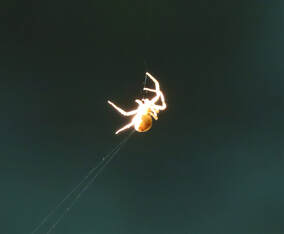Red Fox
|
Brightwood has been home to red foxes for many years. These shy mammals have adapted well to living in suburban environments and are rarely seen by human park visitors. Territorial by nature, they mark trees with their scent to claim the area. It seems that recently the foxes have been facing territorial challenges in the park from new coyote neighbors.
Red foxes belong in the canine family along with dogs, wolves, and coyotes. They have long legs, long fur and bushy tails. Their tails help them with stability and also provide warm fur wraps in cold weather. Red foxes communicate with one another through various vocalizations. They also use their tails in non-verbal communications. Their pointed snouts and noses enable a strong sense of smell. They use this asset to find food sources. Their pointed ears provide sensitive hearing that allows them to detect even underground rodent activity. Though not in the cat family, red foxes have some cat-like characteristics such as whiskers and retractable claws. Their whiskers help them navigate in the dark. Like cats, red foxes have vertical pupils. This type of pupil helps with night vision since it allows more control over the amount of light that enters the eye. With their visual acuity, they tend to be solitary night hunters. Male foxes are called dog foxes; females are called vixens. Baby foxes are called kits. A couple mates once a year and can produce litters of 4 to 5 kits. They stay with their parents about 7 months. During their infancy, both parents tend and feed them. The babies are kept in underground dens to protect them from predators. Foxes are prey for coyotes, owls, and eagles. Omnivores, foxes eat a varied diet – basically whatever they can find. They prefer small rodents but will also feast on birds, frogs, snakes, insects, berries and even scavenge garbage scraps or pet food in suburban areas. In the wild, foxes live around three to four years. Some years ago, Brightwood’s foxes suffered from mange, parasitic skin mites that cause fur loss and skin sores. This type of ailment is particularly troublesome as it deprives the fox of its bushy tail so necessary for its balance and warmth. Read more: HTTPS://KIDS.NATIONALGEOGRAPHIC.COM/ANIMALS/MAMMALS/FACTS/RED-FOX#:~:TEXT=THEY%20HAVE%20LONG%20WHISKERS%2C%20RETRACTABLE,HUNGRY%20KITS%20WAITING%20AT%20HOME. https://www.earthrangers.com/EN/CA/top-10/top-ten-fun-fox-facts/ https://kids.britannica.com/kids/article/fox/353145 https://www.sciencekids.co.nz/sciencefacts/animals/fox.html |
|
Spring is here! Have you seen an American Robin?
|
For more information about robins, check out CornellLab All About Birds!
|
A first sign of Spring is an American robin sighting! With Spring around the corner, it is always exciting to see robins pecking around for their morning worms! But did you know that robins actually live in New Jersey all year round? You just don't see them much in colder weather as they tend to spend their time up in the trees.
Robins have a varied diet of insects and other invertebrates as well as berries and fruits. In the morning, they hunt for worms for breakfast. You may see them walking or standing in grass, sometimes they stare with their heads cocked. Later in the day, they sup on berries. In the winter, they move to wooded areas where berries are in more abundance. Robins generally nest in lower branches of trees or thick vegetation. Their nests are made of twigs, grass, moss, and even bits of paper with mud to mold it and make it sturdy. Robins can have up to three broods a season of between 3-5 eggs. The eggs are a distinctive color that has been described as “robin blue.” The eggs incubate for only 12 to 14 days. The hatchlings have a bit of whitish down at birth. Although they seemingly can reproduce in great numbers, only about 40% of nests are successful. Of the hatchlings that do survive, only about 25% will make it until the fall. Of those, only half will survive a year. Robins are prey to a number of animals and birds. They are particularly vulnerable as young hatchlings. Another threat they face is pesticide laden lawns. As robins forage in the grass seeking earthworms, they are particularly susceptible to these toxins. Even so, American robin numbers are stable and even slightly increased. |
Brightwood's Coyote or Coywolf?
Brightwood Park is home to a variety of wildlife, and at the top of the food chain sits the coyote. Those who have seen a coyote in the park have noted it is rather large. This is a keen and insightful observation.
Historically, coyotes lived in the western United States. It was not until around the 1940s that coyotes made their way past the Appalachian mountains. On their way eastward, coyotes mated with wolves and even some feral dogs.
By the end of the 1800’s settlers had killed off many apex predators such as wolves and mountain lions to protect homesteads and farms. Wolves in search of mates found the coyotes compatible, and the “coywolf” was born. DNA tests on eastern coyotes show that they are a mix of coyote, grey wolf, eastern wolf, and to a lesser extent feral dog. As a result of this mixed geneology, eastern coyotes tend to be larger than their western counterparts.
Coyotes can now be found all along the east coast. They have made themselves at home in suburban and urban areas even taking up residence in New York’s Central Park. They are territorial and mark their area with feces and urine. Generally, their range covers from 4 to 15 miles. Coyotes defend their homestead area from threats of other coyotes who might want to move in on their territory.
Coyotes have a varied diet depending on what is available. They hunt small mammals including rabbits, chipmunks, squirrels and other rodents, red fox and deer. They also eat carrion, amphibians, fish, reptiles, insects, and vegetation such as fruits and berries.
Coyotes mate between January and March. They have 4 to 7 pups that are born blind. Although vulnerable initially, within 2 to 3 weeks they emerge from their den to play. Both parents rear the pups until they can fend for themselves. Though coyotes can live up to 21 years in captivity, they survive only around 6 to 8 years in the wild. Most often killed by humans, they are also fall due to diseases such as mange, distemper and rabies.
Coyotes tend to be skittish of humans. However, if they become accustomed to humans, they may lose some of their fear. Though a coyote sighting is typically not cause for concern, if an animal appears sick, aggressive, or injured please report it to the Westfield Police.
In addition, exercise caution when in an area known to have resident coyotes:
For more information, check out:
https://www.nps.gov/articles/netn-species-spotlight-eastern-coyote.htm#:~:text=Today%2C%20the%20eastern%20coyote%20(one,does%20in%20any%20National%20Park.
```````
Historically, coyotes lived in the western United States. It was not until around the 1940s that coyotes made their way past the Appalachian mountains. On their way eastward, coyotes mated with wolves and even some feral dogs.
By the end of the 1800’s settlers had killed off many apex predators such as wolves and mountain lions to protect homesteads and farms. Wolves in search of mates found the coyotes compatible, and the “coywolf” was born. DNA tests on eastern coyotes show that they are a mix of coyote, grey wolf, eastern wolf, and to a lesser extent feral dog. As a result of this mixed geneology, eastern coyotes tend to be larger than their western counterparts.
Coyotes can now be found all along the east coast. They have made themselves at home in suburban and urban areas even taking up residence in New York’s Central Park. They are territorial and mark their area with feces and urine. Generally, their range covers from 4 to 15 miles. Coyotes defend their homestead area from threats of other coyotes who might want to move in on their territory.
Coyotes have a varied diet depending on what is available. They hunt small mammals including rabbits, chipmunks, squirrels and other rodents, red fox and deer. They also eat carrion, amphibians, fish, reptiles, insects, and vegetation such as fruits and berries.
Coyotes mate between January and March. They have 4 to 7 pups that are born blind. Although vulnerable initially, within 2 to 3 weeks they emerge from their den to play. Both parents rear the pups until they can fend for themselves. Though coyotes can live up to 21 years in captivity, they survive only around 6 to 8 years in the wild. Most often killed by humans, they are also fall due to diseases such as mange, distemper and rabies.
Coyotes tend to be skittish of humans. However, if they become accustomed to humans, they may lose some of their fear. Though a coyote sighting is typically not cause for concern, if an animal appears sick, aggressive, or injured please report it to the Westfield Police.
In addition, exercise caution when in an area known to have resident coyotes:
- Stay on defined trails.
- Keep dogs leashed and close to you.
- Do not approach wildlife.
- Make noise as you walk.
- Exercise extra caution when walking during dawn or dusk.
- Never feed wildlife.
- Leave no trace by carrying all food items out of parks with you and ensuring all garbage has a tight-fitting lid.
For more information, check out:
https://www.nps.gov/articles/netn-species-spotlight-eastern-coyote.htm#:~:text=Today%2C%20the%20eastern%20coyote%20(one,does%20in%20any%20National%20Park.
```````
Brightwood's Ghosts!
Ghosts live in Brightwood Park! That is - ghost pipes, also known as the corpse plant! A completely white plant that does not get its energy from the sun! So, what do these plants use for food?
Most plants get their energy from the sun through a process of photosynthesis. Chlorophyll in the plant transforms sunlight into energy. Since chlorophyll is green, plants are green. When weather turns cold, chlorophyll breaks down and leaves lose their green color. The plants then have to rely upon stored energy until the weather warms up and chlorophyll returns.
But, did you know that there are plants that are not green – hence, no chlorophyll? Without chlorophyll, plants like ghost pipes cannot transform sunlight into energy. How do they survive? They have another way to feed themselves.
Ghost pipes grow in dense or dark forests where they cannot depend on sunlight for energy. Instead, they rely upon energy from trees. Tree leaves with chlorophyll feed the tree. The trees in turn form a partnership underground with a special kind of fungi called mycorrhizas. This fungi fuses with tree roots to help the tree extract water and nutrients from the ground. In exchange, the trees give the fungi carbon-rich sugars. Ghost pipes in turn reap the benefits from those sugars when they mingle with the fungi to exchange nutrients.
At the end of the season, ghost pipes turn black and develop seed pods to ensure their lineage will continue.
Do these ghostly white plants that feed off fungi deserve the moniker, “corpse plants?” For more information, check out these websites:
https://wildadirondacks.org/adirondack-wildflowers-indian-pipe-monotropa-uniflora.html#:~:text=The%20plant%20was%20used%20by,as%20a%20remedy%20for%20toothache.
https://botit.botany.wisc.edu/toms_fungi/oct2002.html
https://www.wildcalifornia.org/post/into-the-haunted-forest-ghost-pipe
https://unrulygardening.com/ghost-pipe-faqs/
https://www.fllt.org/the-ghost-in-the-woods/
Most plants get their energy from the sun through a process of photosynthesis. Chlorophyll in the plant transforms sunlight into energy. Since chlorophyll is green, plants are green. When weather turns cold, chlorophyll breaks down and leaves lose their green color. The plants then have to rely upon stored energy until the weather warms up and chlorophyll returns.
But, did you know that there are plants that are not green – hence, no chlorophyll? Without chlorophyll, plants like ghost pipes cannot transform sunlight into energy. How do they survive? They have another way to feed themselves.
Ghost pipes grow in dense or dark forests where they cannot depend on sunlight for energy. Instead, they rely upon energy from trees. Tree leaves with chlorophyll feed the tree. The trees in turn form a partnership underground with a special kind of fungi called mycorrhizas. This fungi fuses with tree roots to help the tree extract water and nutrients from the ground. In exchange, the trees give the fungi carbon-rich sugars. Ghost pipes in turn reap the benefits from those sugars when they mingle with the fungi to exchange nutrients.
At the end of the season, ghost pipes turn black and develop seed pods to ensure their lineage will continue.
Do these ghostly white plants that feed off fungi deserve the moniker, “corpse plants?” For more information, check out these websites:
https://wildadirondacks.org/adirondack-wildflowers-indian-pipe-monotropa-uniflora.html#:~:text=The%20plant%20was%20used%20by,as%20a%20remedy%20for%20toothache.
https://botit.botany.wisc.edu/toms_fungi/oct2002.html
https://www.wildcalifornia.org/post/into-the-haunted-forest-ghost-pipe
https://unrulygardening.com/ghost-pipe-faqs/
https://www.fllt.org/the-ghost-in-the-woods/
A Lion in Brightwood? Slime Mold!
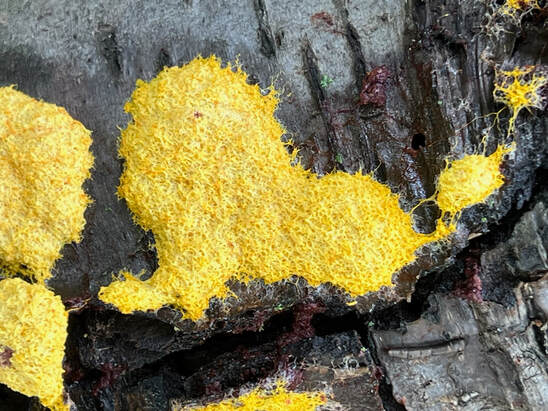 Photo by Chuan-Chu Chou
Photo by Chuan-Chu Chou
Once thought to be a fungus, slime mold is now recognized as a separate class of single celled organisms under the protista grouping. Slime mold includes a number of different kinds of organisms. Brightwood's "lion" is a fuligo septica organism. Known also more colorfully as "dog vomit slime" or, perhaps more pleasantly, as "scrambled egg slime" or "flowers of tan" due to its bright yellow appearance.
This gelatinous slime feeds on microorganisms found on dead or decaying plant material including bacteria and fungi. It can often be found in forests. Brightwood's "lion" was found just inside the fencing along the path on a log.
Slime mold thrives in warm, wet and humid conditions. When the slime mold dries out, its bright color fades to brown or tan.
This gelatinous slime feeds on microorganisms found on dead or decaying plant material including bacteria and fungi. It can often be found in forests. Brightwood's "lion" was found just inside the fencing along the path on a log.
Slime mold thrives in warm, wet and humid conditions. When the slime mold dries out, its bright color fades to brown or tan.
Belted Kingfishers
Kingfishers are found on all continents with over 100 different species. The North American species is called the belted kingfisher, named for the plumage pattern on its neck and breast. The belted kingfisher has blue-grey feathers on its back and a white neck band with a blue-grey band on its breast. Atypical of most birds, the female is a bit showier than the male with second band of chestnut feathers on its chest.
Chuan-Chu Chou’s photos show a male and female pair in Brightwood this summer. The photo of the male’s chest shows its grey banded breast. The photo of the female gives just a glimpse of the chestnut feathers that adorn its breast.
A kingfisher’s crested head with a long, pointed beak make it easily recognizable. It often perches near a clear water source where it surveys the water for its food of choice. In particular, it eats small fish that it can swallow whole. Beyond fish, its diet is varied including berries, and just about anything it can catch from crustaceans, amphibians, reptiles, birds to small mammals.
One of the Brightwood kingfishers was photographed sitting on a branch overlooking the pond. Perching up high gives it a good perspective on potential meals under water. When it finds its prey, it flies above the water, sometimes hovering overhead, and then dives into the water to grab its meal with its beak. Kingfishers are fast and straight flyers with rapid wing movements.
Generally solitary birds, kingfishers pair up during mating seasons. Together, they dig out nests on sloped water banks that they scope out while courting. Ingeniously, they build tunnels in an upward trajectory to prevent water seepage. The tunnel can be from 1’ to 8’ long leading to an interior section that can be 8–12” in diameter and 6–7” high. It may take the couple a week to dig out their nest using their feet.
During mating season, kingfishers are territorial and will defend up to .6 of a mile of waterfront. They drive off competitor kingfishers with rattled cries while flying overhead or by heaving their bodies while perched on a branch. More sensitive to humans, they may abandon a territory where there is human activity.
Kingfishers can produce one to two broods of 5 to 8 eggs. Initially, baby chicks have acids in their stomach that help them digest bones and shells. However, their stomachs evolve as they age, and when matured, they regurgitate undigestible bits in pellets.
A kingfisher makes distinct vocalizations including a rattling sound and high pitched screams. You can hear their calls: https://www.allaboutbirds.org/guide/Belted_Kingfisher/sounds
To learn more, check out:
https://www.allaboutbirds.org/guide/Belted_Kingfisher/overview
https://www.thespruce.com/fun-facts-about-kingfishers-4119330
https://www.trgt.org/bloginput/2021/6/21/the-mysterious-world-of-the-belted-kingfishernbsp#:~:text=Belted%20kingfishers%20get%20their%20common,of%20the%20wind%20god%20Aeolus.
Chuan-Chu Chou’s photos show a male and female pair in Brightwood this summer. The photo of the male’s chest shows its grey banded breast. The photo of the female gives just a glimpse of the chestnut feathers that adorn its breast.
A kingfisher’s crested head with a long, pointed beak make it easily recognizable. It often perches near a clear water source where it surveys the water for its food of choice. In particular, it eats small fish that it can swallow whole. Beyond fish, its diet is varied including berries, and just about anything it can catch from crustaceans, amphibians, reptiles, birds to small mammals.
One of the Brightwood kingfishers was photographed sitting on a branch overlooking the pond. Perching up high gives it a good perspective on potential meals under water. When it finds its prey, it flies above the water, sometimes hovering overhead, and then dives into the water to grab its meal with its beak. Kingfishers are fast and straight flyers with rapid wing movements.
Generally solitary birds, kingfishers pair up during mating seasons. Together, they dig out nests on sloped water banks that they scope out while courting. Ingeniously, they build tunnels in an upward trajectory to prevent water seepage. The tunnel can be from 1’ to 8’ long leading to an interior section that can be 8–12” in diameter and 6–7” high. It may take the couple a week to dig out their nest using their feet.
During mating season, kingfishers are territorial and will defend up to .6 of a mile of waterfront. They drive off competitor kingfishers with rattled cries while flying overhead or by heaving their bodies while perched on a branch. More sensitive to humans, they may abandon a territory where there is human activity.
Kingfishers can produce one to two broods of 5 to 8 eggs. Initially, baby chicks have acids in their stomach that help them digest bones and shells. However, their stomachs evolve as they age, and when matured, they regurgitate undigestible bits in pellets.
A kingfisher makes distinct vocalizations including a rattling sound and high pitched screams. You can hear their calls: https://www.allaboutbirds.org/guide/Belted_Kingfisher/sounds
To learn more, check out:
https://www.allaboutbirds.org/guide/Belted_Kingfisher/overview
https://www.thespruce.com/fun-facts-about-kingfishers-4119330
https://www.trgt.org/bloginput/2021/6/21/the-mysterious-world-of-the-belted-kingfishernbsp#:~:text=Belted%20kingfishers%20get%20their%20common,of%20the%20wind%20god%20Aeolus.
Beaver, Muskrat or Otter?
Photos by Chuan-Chu Chou
After careful consideration, our brain pool says muskrat. Though it looks a lot like a beaver, the hint as to its identification is in how it is swimming. Beavers swim with just their heads above water. This couple was swimming with their body showing above water. The mystery remains as to where they came from and how they found Brightwood Park in the middle of suburban sprawl! Photos courtesy of Chuan-Chu Chou
Tiny but Essential Forest Dwellers: Chipmunks
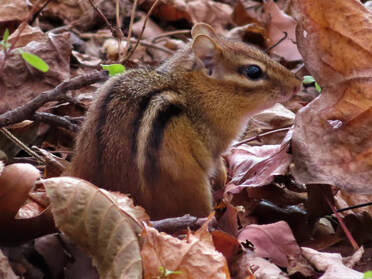 All photos courtesy of Chuan-Chu Chou
All photos courtesy of Chuan-Chu Chou
Walking in a forest is a sensory experience. What you see and hear can give clues as to birds or animals that might be nearby. You might hear the drumming of a woodpecker or the croak of a frog. If you hear a chirping sound, it might be a bird, but it might also be a chipmunk.
Though chipmunks tend to scamper around soundlessly, you may hear them chirping, chipping, clucking, or even trilling. They mostly do this to warn other chipmunks in the area about potential predators, but on occasion, they also use their voice to defend their territory from other chipmunk’s encroachment.
If you are lucky enough to glimpse a chipmunk in Brightwood Park, you are looking at an eastern chipmunk, a native species to New Jersey. They can grow to between 8” to 10” and weigh between 2 to 5 ounces. Chipmunks are the smallest member of the squirrel family.
Chipmunks are mostly solitary creatures. They stake out a territory and mark it with their scent. They are prepared to defend their area should another chipmunk intrude.
Eastern chipmunks do seek out each other two times a year (spring and summer) to mate, and females can have litters of four to five “kits” or “pups” twice a year. The pups, born the size of a bumblebee, are hairless and blind. Moms raise pups alone with no help from their dads. The pups come out of the burrow for the first time around six weeks and leave it for good to strike out on their own at about eight weeks.
Chipmunks live alone in burrows they dig in the ground. Like little architects, they build homes with features that will help them live comfortably and safely. Their burrows can be between 10’ to 30’ long and run about 3’ deep with a number of entrances to help them evade predators and to escape tunnel collapses and flooding.
Chipmunk homes include a number of chambers and side pockets. Each entrance tunnel leads to a main nesting chamber. This chamber is insulated with various materials the chipmunk gathers from the forest including leaves, grass, and other plant fibers. The chipmunk spends most of its time in this chamber – sleeping up to 15 hours a day!
The burrow’s side pockets and other chambers are used to store food and provide space for the chipmunk to maneuver or turn around in tight spots. Extra food is also stored in the nesting chamber in the colder winter months for easy access. Chipmunks also build some drainage tunnels to help direct water out of the burrow.
Chipmunks are omnivores and eat a wide variety of foods including nuts, seeds, berries, flowers, mushrooms, worms, snails, frogs, and even small bird eggs. In the eat and be eaten existence of forest animals, chipmunks are prey for snakes, owls and other birds of prey such as hawks, and larger mammals including fox, coyote, raccoons, and even housecats.
Chipmunks are diurnal, meaning that they are active in the day. You can find them busiest at dawn and dusk. They mostly gather food from the forest floor, but they are able to climb trees to gather nuts and acorns.
Mid-summer through fall, chipmunks gather up non-perishable food stores in their burrows for the winter months. A chipmunk can gather up over a hundred acorns in a single day. They collect the food in their cheek pouches to carry it back to their burrows for storage.
For about four months, during colder weather, they go into a state of torpor - similar to a short hibernation. In this state, a chipmunk lowers its body temperature and its heart, breathing and metabolic rates. This allows it to survive for a period of days while it sleeps. It comes out of this state every few days to eat and relieve itself.
Chipmunks are important forest residents who help keep the ecosystem viable. Their foraging helps spread seeds in the forest and encourages seedling growth. By eating and dispersing mycorrhizal fungi spores near tree roots, they help keep trees and other plants healthy.This fungus has evolved to depend on chipmunks and other small mammals to disperse its spores that enrich the soil and help trees and other plants absorb water and nutrients.
Though chipmunks tend to scamper around soundlessly, you may hear them chirping, chipping, clucking, or even trilling. They mostly do this to warn other chipmunks in the area about potential predators, but on occasion, they also use their voice to defend their territory from other chipmunk’s encroachment.
If you are lucky enough to glimpse a chipmunk in Brightwood Park, you are looking at an eastern chipmunk, a native species to New Jersey. They can grow to between 8” to 10” and weigh between 2 to 5 ounces. Chipmunks are the smallest member of the squirrel family.
Chipmunks are mostly solitary creatures. They stake out a territory and mark it with their scent. They are prepared to defend their area should another chipmunk intrude.
Eastern chipmunks do seek out each other two times a year (spring and summer) to mate, and females can have litters of four to five “kits” or “pups” twice a year. The pups, born the size of a bumblebee, are hairless and blind. Moms raise pups alone with no help from their dads. The pups come out of the burrow for the first time around six weeks and leave it for good to strike out on their own at about eight weeks.
Chipmunks live alone in burrows they dig in the ground. Like little architects, they build homes with features that will help them live comfortably and safely. Their burrows can be between 10’ to 30’ long and run about 3’ deep with a number of entrances to help them evade predators and to escape tunnel collapses and flooding.
Chipmunk homes include a number of chambers and side pockets. Each entrance tunnel leads to a main nesting chamber. This chamber is insulated with various materials the chipmunk gathers from the forest including leaves, grass, and other plant fibers. The chipmunk spends most of its time in this chamber – sleeping up to 15 hours a day!
The burrow’s side pockets and other chambers are used to store food and provide space for the chipmunk to maneuver or turn around in tight spots. Extra food is also stored in the nesting chamber in the colder winter months for easy access. Chipmunks also build some drainage tunnels to help direct water out of the burrow.
Chipmunks are omnivores and eat a wide variety of foods including nuts, seeds, berries, flowers, mushrooms, worms, snails, frogs, and even small bird eggs. In the eat and be eaten existence of forest animals, chipmunks are prey for snakes, owls and other birds of prey such as hawks, and larger mammals including fox, coyote, raccoons, and even housecats.
Chipmunks are diurnal, meaning that they are active in the day. You can find them busiest at dawn and dusk. They mostly gather food from the forest floor, but they are able to climb trees to gather nuts and acorns.
Mid-summer through fall, chipmunks gather up non-perishable food stores in their burrows for the winter months. A chipmunk can gather up over a hundred acorns in a single day. They collect the food in their cheek pouches to carry it back to their burrows for storage.
For about four months, during colder weather, they go into a state of torpor - similar to a short hibernation. In this state, a chipmunk lowers its body temperature and its heart, breathing and metabolic rates. This allows it to survive for a period of days while it sleeps. It comes out of this state every few days to eat and relieve itself.
Chipmunks are important forest residents who help keep the ecosystem viable. Their foraging helps spread seeds in the forest and encourages seedling growth. By eating and dispersing mycorrhizal fungi spores near tree roots, they help keep trees and other plants healthy.This fungus has evolved to depend on chipmunks and other small mammals to disperse its spores that enrich the soil and help trees and other plants absorb water and nutrients.
Milkweed and Monarchs
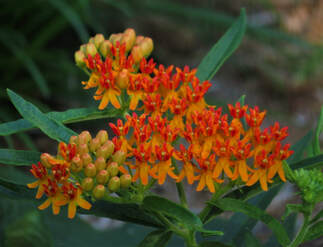 Photo courtesy of Chuan-Chu Chou
Photo courtesy of Chuan-Chu Chou
Milkweed by any other name would still smell as sweet. The dozens of varieties of milkweed bear flower clusters of pink, purple, orange, red, white, yellow and green. The flowers scent the air with a sweet vanilla fragrance. Milkweed nectar attracts a plethora of pollinators including butterflies, bees, moths, and hummingbirds.
So, why call this beautiful and fragrant flower producing plant a “weed?” A weed, after all, by definition is a plant that grows where it is not wanted. Who would not want such a flower around? Historically, farmers found this plant to be particularly pesky. It competes with crops for soil space and sun. Its milk-infused leaves are toxic to livestock and has deadly consequences for mammals that consume them. As a result, milkweed has been viewed as a problem plant to be eradicated from the agricultural landscape by any means necessary.
More recently, milkweed is gaining respect and a deeper appreciation – even by farmers. It is now recognized as an important source of attraction for pollinators, upon which crops depend. Additionally, its significance to one particular pollinator has raised appreciation of its importance to a biodiverse world.
In 2022, monarch butterflies were placed on the endangered species list due to loss of habitat and climate change. Their “habitat” requires milkweed for survival. Monarch butterflies are certainly beautiful to look at, but more than that, they capture the imagination. How can something so delicate survive and thrive under extreme conditions?
Watching a monarch flit from flower to flower on powdery wings as thin as a piece of paper makes it all the harder to imagine it flying up to 2,500 miles on the journey from New Jersey or even Canada to the central Mexican forests to winter. Having existed for about 2 million years, they evolved reliant on their native landscape – and, in particular, milkweed, which was once abundant on their journey.
The life-cycle of the monarch has four stages: egg, caterpillar, pupa or chrysalis, and butterfly. In the course of a year, a monarch goes through four generations with only the last of these making the long trek south.
In February or March of each year, monarch butterflies migrate north after their Mexican winter hibernation. As they head north, they mate and then lays eggs on milkweed leaves. Baby caterpillars hatch after about four days. The caterpillars must have milkweed leaves for both sustenance and protection from predation due to the toxicity they assume from eating the milky plant. Caterpillars reach maturity in about two weeks, at which point, they seek out a place to spin a chrysalis and begin the metamorphosis process.
The metamorphosis from caterpillar to butterfly occurs in just ten days. The monarch butterfly emerges from the chrysalis and takes flight. It spends the next two to six weeks feeding on the nectar of flowers as this first generation continues a northern migration.. A monarch can travel up to 100 miles a day. On its journey, it likewise mates, finds milkweed, lays eggs on a leaf, and then dies.
This process is repeated twice more with 2nd and 3rd generations born in May/June and July/August with the butterflies reaching their northernmost destination. The 4th generation butterflies are born in September/October. Amazingly, this 4th generation takes clues from the environment to begin a 1,200 to 2,500 mile journey to a warmer climate. Since they are cold-blooded, they will freeze and die if they remain in the colder climate.
These 4th generation monarchs make their way to the Sierra Madre Mountains in Mexico. They use thermal and air currents to make this journey. Scientists believe that they may use the position of the sun or the earth's magnetic pull to find their way. At their destination, the monarchs where gather together in large numbers on trees. In temperatures between 30°F to 60°F, the butterflies enter a dormant or hibernating state. When the temperature warms in February or March, they begin the cycle once again with a northward journey. This last generation of monarch butterflies live up to 8 or 9 months – well exceeding the earlier generations that only live two to six weeks in a butterfly state.
This extraordinary life cycle is entirely dependent on the availability of milkweed.
So, why call this beautiful and fragrant flower producing plant a “weed?” A weed, after all, by definition is a plant that grows where it is not wanted. Who would not want such a flower around? Historically, farmers found this plant to be particularly pesky. It competes with crops for soil space and sun. Its milk-infused leaves are toxic to livestock and has deadly consequences for mammals that consume them. As a result, milkweed has been viewed as a problem plant to be eradicated from the agricultural landscape by any means necessary.
More recently, milkweed is gaining respect and a deeper appreciation – even by farmers. It is now recognized as an important source of attraction for pollinators, upon which crops depend. Additionally, its significance to one particular pollinator has raised appreciation of its importance to a biodiverse world.
In 2022, monarch butterflies were placed on the endangered species list due to loss of habitat and climate change. Their “habitat” requires milkweed for survival. Monarch butterflies are certainly beautiful to look at, but more than that, they capture the imagination. How can something so delicate survive and thrive under extreme conditions?
Watching a monarch flit from flower to flower on powdery wings as thin as a piece of paper makes it all the harder to imagine it flying up to 2,500 miles on the journey from New Jersey or even Canada to the central Mexican forests to winter. Having existed for about 2 million years, they evolved reliant on their native landscape – and, in particular, milkweed, which was once abundant on their journey.
The life-cycle of the monarch has four stages: egg, caterpillar, pupa or chrysalis, and butterfly. In the course of a year, a monarch goes through four generations with only the last of these making the long trek south.
In February or March of each year, monarch butterflies migrate north after their Mexican winter hibernation. As they head north, they mate and then lays eggs on milkweed leaves. Baby caterpillars hatch after about four days. The caterpillars must have milkweed leaves for both sustenance and protection from predation due to the toxicity they assume from eating the milky plant. Caterpillars reach maturity in about two weeks, at which point, they seek out a place to spin a chrysalis and begin the metamorphosis process.
The metamorphosis from caterpillar to butterfly occurs in just ten days. The monarch butterfly emerges from the chrysalis and takes flight. It spends the next two to six weeks feeding on the nectar of flowers as this first generation continues a northern migration.. A monarch can travel up to 100 miles a day. On its journey, it likewise mates, finds milkweed, lays eggs on a leaf, and then dies.
This process is repeated twice more with 2nd and 3rd generations born in May/June and July/August with the butterflies reaching their northernmost destination. The 4th generation butterflies are born in September/October. Amazingly, this 4th generation takes clues from the environment to begin a 1,200 to 2,500 mile journey to a warmer climate. Since they are cold-blooded, they will freeze and die if they remain in the colder climate.
These 4th generation monarchs make their way to the Sierra Madre Mountains in Mexico. They use thermal and air currents to make this journey. Scientists believe that they may use the position of the sun or the earth's magnetic pull to find their way. At their destination, the monarchs where gather together in large numbers on trees. In temperatures between 30°F to 60°F, the butterflies enter a dormant or hibernating state. When the temperature warms in February or March, they begin the cycle once again with a northward journey. This last generation of monarch butterflies live up to 8 or 9 months – well exceeding the earlier generations that only live two to six weeks in a butterfly state.
This extraordinary life cycle is entirely dependent on the availability of milkweed.
For more information, check out:
- https://www.fs.usda.gov/wildflowers/pollinators/Monarch_Butterfly/index.shtml
- https://www.iucn.org/press-release/202207/migratory-monarch-butterfly-now-endangered-iucn-red-list
- https://blogs.edf.org/growingreturns/2017/09/07/once-a-pesky-plant-for-farmers-this-weed-presents-a-new-opportunity/#:~:text=Milkweed%20has%20a%20reputation%20for,areas%20as%20a%20last%20resort.
- https://extension.umaine.edu/signs-of-the-seasons/indicator-species/milkweed-fact-sheet/#:~:text=Common%20milkweed%20is%20a%20perennial,in%20its%20leaves%20and%20stems.
- https://tellus.ars.usda.gov/stories/articles/which-milkweeds-do-monarch-butterflies-prefer/#:~:text=Female%20monarchs%20will%20lay%20eggs,the%20highest%20number%20of%20eggs.
- https://www.cityofirving.org/2737/Monarch-Butterfly-Life-Cycle#:~:text=Monarch%20butterflies%20go%20through%20four,)%2C%20and%20the%20adult%20butterfly.
- https://www.worldwildlife.org/species/monarch-butterfly
- https://www.learnaboutnature.com/insects/butterflies/monarch-butterfly-migration/
Ring-Necked Ducks
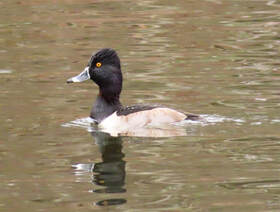 All photos courtesy of Chuan-Chu Chou
All photos courtesy of Chuan-Chu Chou
Brightwood Park has some special visitors this winter. Three ring-necked ducks dropped in on the mallard and Canadian geese on the ponds. The three ducks left and returned with friends! Though they are known to visit small ponds and hang out with other waterfowl in the winter, they have not often been spotted in Brightwood.
These ducks seem to have a curious name since they do not sport a readily apparent ring around their neck. However, some 19th century biologists named them for chestnut colored feathers that ring the black ones of their head, back and chest. Even their scientific name, collaris (translated to “of the neck”), takes off on this not so distinctive feature.
Most of these duck visitors were male. They had black, grey and white plumage. Their heads have a distinctive shape with a peak that can help to identify them. When the three returned, they brought along a female. Female rind-necked ducks are mostly brown with a lighter color facial feather. (See the slide show below.)
Ring-necked ducks are divers who feed mostly in shallow waters. They can be found in marshy areas, small bodies of water, or even flooded fields. They enjoy all parts of aquatic plants including seeds, stems and roots in addition to algae. They also eat insects and mollusks. A young ring-necked duck survives mainly on insects.
Male ring-necked ducks court females in the winter. Their courting includes splaying their head feathers, and thrusting their heads forward and back. Pairs will select nest sites near water for spring eggs. The females incubate eggs for 25-29 days. When ducklings hatch, they are able to swim within 12 to 24 hours. The mother duck leads them to water, where the ducklings will find their own food. In 49 to 55 days, the babies are ready to fly. Their mothers stay with them until they are ready to fledge.
Ring-necked ducks are on the smaller side, but they are strong fliers. They are able to take off directly from water by springing up out of it unlike other diving ducks that must perform a running take-off.
For more information on these interesting ducks, check out:
If you would like to listen to the sounds these ducks make, you can hear them at:
These ducks seem to have a curious name since they do not sport a readily apparent ring around their neck. However, some 19th century biologists named them for chestnut colored feathers that ring the black ones of their head, back and chest. Even their scientific name, collaris (translated to “of the neck”), takes off on this not so distinctive feature.
Most of these duck visitors were male. They had black, grey and white plumage. Their heads have a distinctive shape with a peak that can help to identify them. When the three returned, they brought along a female. Female rind-necked ducks are mostly brown with a lighter color facial feather. (See the slide show below.)
Ring-necked ducks are divers who feed mostly in shallow waters. They can be found in marshy areas, small bodies of water, or even flooded fields. They enjoy all parts of aquatic plants including seeds, stems and roots in addition to algae. They also eat insects and mollusks. A young ring-necked duck survives mainly on insects.
Male ring-necked ducks court females in the winter. Their courting includes splaying their head feathers, and thrusting their heads forward and back. Pairs will select nest sites near water for spring eggs. The females incubate eggs for 25-29 days. When ducklings hatch, they are able to swim within 12 to 24 hours. The mother duck leads them to water, where the ducklings will find their own food. In 49 to 55 days, the babies are ready to fly. Their mothers stay with them until they are ready to fledge.
Ring-necked ducks are on the smaller side, but they are strong fliers. They are able to take off directly from water by springing up out of it unlike other diving ducks that must perform a running take-off.
For more information on these interesting ducks, check out:
- Audubon website https://www.audubon.org/field-guide/bird/ring-necked-duck, and
- All about birds: https://www.allaboutbirds.org/guide/Ring-necked_Duck#
If you would like to listen to the sounds these ducks make, you can hear them at:
American Bullfrog |
Brightwood Park is home to many bullfrogs. If you are quiet and lucky, in warm weather you might see them sitting in the water just along the pond edge. In the spring and summer, you can hear their distinctive calls in the park. They sound like they are saying, “jug-o-rum.” But what happens to bullfrogs in the winter?
Like turtles, bullfrogs are cold-blooded. Their temperature fluctuates with their environment. When the temperature turns freezing, they take up residence on the bottom of the ponds where the water temperature remains above freezing. They take in oxygen as the water moves over their skin. They don’t burrow in the mud but may slowly swim around or rest on the bottom. Bullfrogs’ bodies are also designed to produce more glucose while they hibernate to increase blood sugar levels that act like an anti-freeze. Bullfrogs can survive winter in hibernation because their metabolism slows down to preserve energy stores. Metabolism is the process a body uses to make energy. There is less need for energy in hibernation, so a bullfrog can exist without eating. However, bullfrogs need to be careful not to stop their “hibernation” too early if unseasonably warm weather fools them into believing spring has come. If they surface and begin to warm up, they can meet a tragic fate if winter weather returns. When the weather truly warms up, bullfrogs emerge. As their bodies adjust, their heart and lungs begin to work, and their metabolism speeds up once again. Bullfrogs are either green or brown. They may have splotches on their backs. Their ears called tympanum are located just behind their eyes. They have a skin ridge that ends just behind the tympanum that distinguishes them from green frogs whose ridge carries on down their backs. Male bullfrogs have a yellowish underbelly. Females are white. Males also have larger tympanums than females. On a male, the tympanum can be larger than its eyes. Bullfrogs use their calls to attract mates and establish their territory. You can listen to their call here: https://www.youtube.com/watch?v=QukK4nM9OpA Female bullfrogs lay up to 20,000 eggs at a time. The male bullfrog then comes and fertilizes the eggs. Tadpoles hatch from the eggs and take up to two years to mature into bullfrogs. In the wild, bullfrogs are thought to live between 7 to 9 years. Young tadpoles eat primarily vegetation but their diet expands as they grow. Adult bullfrogs will eat just about anything they can catch with their tongues. They are opportunistic and eat whatever comes along. Their diet can include crustaceans, snakes, fish eggs, bugs, salamanders, worms, bats, crayfish, fish, frogs, and even small rodents or young ducks. Bullfrogs are the largest frogs in this country. They can grow to between 3.5” and 8.” They are native to the Canada and mid-west to eastern United States. Due to human transportation of bullfrogs, they have spread to the western States and other parts of the world. Cultivated for food, bullfrogs are now taking up residence far and wide creating problems as an invasive species in their new habitats. For more information, check out: https://www.nj.gov/dep/fgw/ensp/pdf/frogs.pdf |
Brightwood Park Turtles |
Brightwood is home to many turtles, including eastern painted and red-eared sliders shown in the photo. All spring, summer and early fall you can find them sunning themselves on logs and other materials in the water. When the weather turns cold, the turtles disappear. Where do they go, and how do they survive? Click here to read about these fascinating animals that have lungs and need to breathe air but can survive months underwater. How do they do it? Surprising hint: they breathe through their butts! Click here to learn more! |
Sugar Maples - The Giving Trees
|
Brightwood Park is home to many sugar maple trees that give us brilliant Fall foliage. These trees are very important for the shelter and food they offer to Brightwood's wildlife. Click here to learn about why these plants are so important and how climate change is threatening them.
|
Bats... Scary or Gentle Creatures of the Night?
|
Have you noticed boxes on poles in the park? Ever wondered why they are there? They are bat houses, i.e. homes to encourage bats to take up residence. Many people think that bats are creepy, scary, spooky. After all, don’t they suck blood? So, why would we want to encourage them to hang around the park. The truth is that bats are really shy, gentle, intelligent and misunderstood creatures that are part of a healthy ecosystem. Read more about bats here. |
Mysterious Lichens
|
Lacy patches of grey, tufts of orange string, green leaf-like growth, colorful crust covers on rocks or trees ... what are these mystery organisms found throughout Brightwood Park? They vary in shape and color and can be found growing on rocks, trees, and other surfaces. Not to be confused with moss, lichens are a mysterious organism.
Lichens are found all over the earth from polar regions to the tropics! Most grow on land but a small percentage can even live in water. They are especially unique in that they are comprised of both fungi and alga –in this symbiosis, each component sustains the other. The fungus provides moisture allowing alga to grow in otherwise inhospitable climates. Alga absorbs nutrients and uses photosynthesis to create food thereby feeding the fungus. Read more about lichens here. |
Squirrels
Flickers
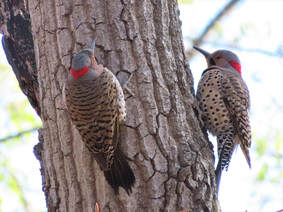 Photo by Chuan-Chu Chou
Photo by Chuan-Chu Chou
Who are Pollinators and Why are they important?
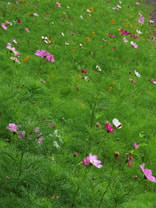
Brightwood Ducks
Mighty Oak Trees
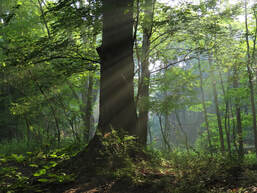 Photo by Chuan-Chu Chou
Photo by Chuan-Chu Chou
Herons
|
During the warmer months, you may see some large wading birds in the pond looking for a meal or a quiet place to hang out. Herons grace our ponds but can be a bit skittish when humans come around. You have to be quiet and patient or they will fly off. When great blue herons fly, they curve their neck in an "S" share (similar to the photo) and tuck their long legs up. Read more about herons here. |
Leaves
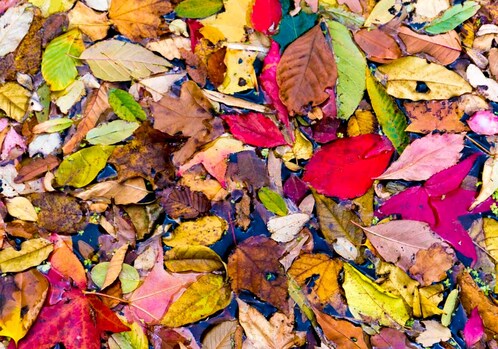 Photo by Lloyd Marks, MD, Ph.D.
Photo by Lloyd Marks, MD, Ph.D.
Why do leaves change color in the Fall?
In spring and summer, leaves have chlorophyll that uses sunlight to make food the tree needs. Since chlorophyll is green, leaves are green when there is a lot of sunlight – like longer summer days.
When the weather turns cooler and the daylight gets shorter, the chlorophyll breaks down, and leaves stop making food.
Without green chlorophyll, other colors in the leaves stand out. For example, some yellow and orange pigments masked by the green become visible in the fall.
Some other leaves have mixtures of colors from pigment and chemical changes that turn the leaves red, purple or brown.
For more information: https://www.esf.edu/pubprog/brochure/leaves/leaves.htm
In spring and summer, leaves have chlorophyll that uses sunlight to make food the tree needs. Since chlorophyll is green, leaves are green when there is a lot of sunlight – like longer summer days.
When the weather turns cooler and the daylight gets shorter, the chlorophyll breaks down, and leaves stop making food.
Without green chlorophyll, other colors in the leaves stand out. For example, some yellow and orange pigments masked by the green become visible in the fall.
Some other leaves have mixtures of colors from pigment and chemical changes that turn the leaves red, purple or brown.
For more information: https://www.esf.edu/pubprog/brochure/leaves/leaves.htm
Spiders Are Everywhere!
|
So many spiders. They say you are never more than a few feet from a spider. They are artists creating elaborate webs and romantics listening for love on web threads for potential mates. What's not to love? Click here to find out more about spiders and listen to the sounds of their webs. |
LocationBrightwood Park is on the North end of Prospect Street. Go past Franklin School and look for the entrance on the left.
|
|
